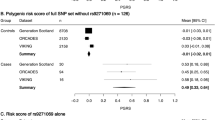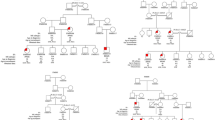Abstract
Multiple sclerosis (MS) is a chronic inflammatory disease of the central nervous system with presumed autoimmune origin, triggered by genetic and environmental risk factors. A recent genome-wide association study conducted on MS identified new biallelic markers outside the HLA (human leucocyte antigen) region involved in disease susceptibility: rs1109670 (DDEF2); rs1458175 (PDZRN4); rs1529316 and rs2049306 (CSMD1); rs16914086 (TBC1D2); rs1755289 (SH3GL2); rs1841770 (ZIC1); rs651477 (EN1); rs7607490 (TRIB2); rs397020 (C20orf46); rs908821 (SLC25A36); rs7672826 (MGC45800) and rs9523762 (GPC5). We aimed at replicating these top association signals in a Spanish cohort of 2863 MS patients and 2930 sex- and age-matched controls. Only rs9523762 mapping in the GPC5 gene was significantly associated (G allele, P=1.6 × 10−5; odds ratio (95% confidence interval)=1.23 (1.12–1.36)), supporting a role for this proteoglycan in MS predisposition. The independent replication of association signals to validate data generated by genome-wide association scans is a first step in the effort to improve patient care.
This is a preview of subscription content, access via your institution
Access options
Subscribe to this journal
Receive 6 digital issues and online access to articles
$119.00 per year
only $19.83 per issue
Buy this article
- Purchase on Springer Link
- Instant access to full article PDF
Prices may be subject to local taxes which are calculated during checkout
Similar content being viewed by others
References
Frohman EM, Racke MK, Raine CS . Multiple sclerosis--the plaque and its pathogenesis. N Engl J Med 2006; 354: 942–955.
Fugger L, Friese MA, Bell JI . From genes to function: the next challenge to understanding multiple sclerosis. Nat Rev Immunol 2009; 9: 408–417.
Ramagopalan SV, Dyment DA, Ebers GC . Genetic epidemiology: the use of old and new tools for multiple sclerosis. Trends Neurosci 2008; 31: 645–652.
Jersild C, Svejgaard A, Fog T . HL-A antigens and multiple sclerosis. Lancet 1972; 1: 1240–1241.
Oksenberg JR, Baranzini SE, Sawcer S, Hauser SL . The genetics of multiple sclerosis: SNPs to pathways to pathogenesis. Nat Rev Genet 2008; 9: 516–526.
Donnelly P . Progress and challenges in genome-wide association studies in humans. Nature 2008; 456: 728–731.
Lettre G, Rioux JD . Autoimmune diseases: insights from genome-wide association studies. Hum Mol Genet 2008; 17: R116–R121.
Rioux JD, Xavier RJ, Taylor KD, Silverberg MS, Goyette P, Huett A et al. Genome-wide association study identifies new susceptibility loci for Crohn disease and implicates autophagy in disease pathogenesis. Nat Genet 2007; 39: 596–604.
Wellcome Trust Case Control Consortium. Genome-wide association study of 14 000 cases of seven common diseases and 3000 shared controls. Nature 2007; 447: 661–678.
Hafler DA, Compston A, Sawcer S, Lander ES, Daly MJ, De Jager PL et al. Risk alleles for multiple sclerosis identified by a genomewide study. N Engl J Med 2007; 357: 851–862.
Australia and New Zealand Multiple Sclerosis Genetics Consortium (ANZgene). Genome-wide association study identifies new multiple sclerosis susceptibility loci on chromosomes 12 and 20. Nat Genet 2009; 41: 824–828.
Hoppenbrouwers IA, Aulchenko YS, Janssens AC, Ramagopalan SV, Broer L, Kayser M et al. Replication of CD58 and CLEC16A as genome-wide significant risk genes for multiple sclerosis. J Hum Genet 2009; 54: 676–680.
Rubio JP, Stankovich J, Field J, Tubridy N, Marriott M, Chapman C et al. Replication of KIAA0350, IL2RA, RPL5 and CD58 as multiple sclerosis susceptibility genes in Australians. Genes Immun 2008; 9: 624–630.
Baranzini SE, Wang J, Gibson RA, Galwey N, Naegelin Y, Barkhof F et al. Genome-wide association analysis of susceptibility and clinical phenotype in multiple sclerosis. Hum Mol Genet 2009; 18: 767–778.
Ioannidis JP, Thomas G, Daly MJ . Validating, augmenting and refining genome-wide association signals. Nat Rev Genet 2009; 10: 318–329.
Pearson TA, Manolio TA . How to interpret a genome-wide association study. JAMA 2008; 299: 1335–1344.
Luxardi G, Galli A, Forlani S, Lawson K, Maina F, Dono R . Glypicans are differentially expressed during patterning and neurogenesis of early mouse brain. Biochem Biophys Res Commun 2007; 352: 55–60.
van Horssen J, Bo L, Dijkstra CD, de Vries HE . Extensive extracellular matrix depositions in active multiple sclerosis lesions. Neurobiol Dis 2006; 24: 484–491.
Byun E, Caillier SJ, Montalban X, Villoslada P, Fernandez O, Brassat D et al. Genome-wide pharmacogenomic analysis of the response to interferon beta therapy in multiple sclerosis. Arch Neurol 2008; 65: 337–344.
Cenit MD, Blanco-Kelly F, de las Heras V, Bartolome M, de la Concha EG, Urcelay E et al. Glypican 5 is an interferon-beta response gene: a replication study. Mult Scler 2009; 15: 913–917.
Johnson BA, Wang J, Taylor EM, Caillier SJ, Herbert J, Khan OA et al. Multiple sclerosis susceptibility alleles in African Americans. Genes Immun 2010; 11: 343–350.
Arking DE, Reinier K, Post W, Jui J, Hilton G, O’Connor A et al. Genome-wide association study identifies GPC5 as a novel genetic locus protective against sudden cardiac arrest. PLoS One 2010; 5: e9879.
Li Y, Sheu CC, Ye Y, de Andrade M, Wang L, Chang SC et al. Genetic variants and risk of lung cancer in never smokers: a genome-wide association study. Lancet Oncol 2010; 11: 321–330.
Karlsen TH, Franke A, Melum E, Kaser A, Hov JR, Balschun T et al. Genome-wide association analysis in primary sclerosing cholangitis. Gastroenterology 2010; 138: 1102–1111.
Yu W, Inoue J, Imoto I, Matsuo Y, Karpas A, Inazawa J . GPC5 is a possible target for the 13q31-q32 amplification detected in lymphoma cell lines. J Hum Genet 2003; 48: 331–335.
De Jager PL, Jia X, Wang J, de Bakker PI, Ottoboni L, Aggarwal NT et al. Meta-analysis of genome scans and replication identify CD6, IRF8 and TNFRSF1A as new multiple sclerosis susceptibility loci. Nat Genet 2009; 41: 776–782.
Weiner HL . The challenge of multiple sclerosis: how do we cure a chronic heterogeneous disease? Ann Neurol 2009; 65: 239–248.
Zuvich RL, McCauley JL, Pericak-Vance MA, Haines JL . Genetics and pathogenesis of multiple sclerosis. Semin Immunol 2009; 21: 328–333.
Manolio TA, Collins FS, Cox NJ, Goldstein DB, Hindorff LA, Hunter DJ et al. Finding the missing heritability of complex diseases. Nature 2009; 461: 747–753.
Gourh P, Agarwal SK, Divecha D, Assassi S, Paz G, Arora-Singh RK et al. Polymorphisms in TBX21 and STAT4 increase the risk of systemic sclerosis: evidence of possible gene-gene interaction and alterations in Th1/Th2 cytokines. Arthritis Rheum 2009; 60: 3794–3806.
Perdigones N, Vigo AG, Lamas JR, Martínez A, Balsa A, Pascual-Sacedo D et al. Evidence of epistasis between TNFRSF14 and TNFRSF6B polymorphisms in patients with rheumatoid arthritis. Arthritis Rheum 2010; 62: 705–710.
Hirschhorn JN . Genomewide association studies--illuminating biologic pathways. N Engl J Med 2009; 360: 1699–1701.
Carroll WM . Oral Therapy for Multiple Sclerosis -- Sea Change or Incremental Step? N Engl J Med 2010; 362: 456–458.
Lopez-Diego RS, Weiner HL . Novel therapeutic strategies for multiple sclerosis--a multifaceted adversary. Nat Rev Drug Discov 2008; 7: 909–925.
Poser CM . Revisions to the 2001 McDonald diagnostic criteria. Ann Neurol 2006; 59: 727–728.
Acknowledgements
We thank patients with multiple sclerosis and control subjects for making this study feasible. Financial support for the study was provided by: Ministerio de Ciencia e Innovación-Feder (SAF2009-11491), Fondo de Investigación Sanitaria FIS (RETICS-REEM RD07/0060, PI0902105, PI081636, PI070353) Junta de Andalucía (P07-CVI-02551), Fundación Ilundain, and Ikerbasque, the Basque Foundation for Science (Bilbao). SNP genotyping services were provided by the Spanish ‘Centro Nacional de Genotipado’ CEGEN-USC, www.cegen.org.
Author information
Authors and Affiliations
Corresponding author
Ethics declarations
Competing interests
The authors declare no conflict of interest.
Additional information
Supplementary Information accompanies the paper on Genes and Immunity website
Supplementary information
Rights and permissions
About this article
Cite this article
Cavanillas, M., Fernández, O., Comabella, M. et al. Replication of top markers of a genome-wide association study in multiple sclerosis in Spain. Genes Immun 12, 110–115 (2011). https://doi.org/10.1038/gene.2010.52
Received:
Revised:
Accepted:
Published:
Issue Date:
DOI: https://doi.org/10.1038/gene.2010.52
Keywords
This article is cited by
-
An investigation of genetic polymorphisms in heparan sulfate proteoglycan core proteins and key modification enzymes in an Australian Caucasian multiple sclerosis population
Human Genomics (2020)
-
An expression atlas of human primary cells: inference of gene function from coexpression networks
BMC Genomics (2013)
-
ANKRD55 and DHCR7 are novel multiple sclerosis risk loci
Genes & Immunity (2012)
-
Single nucleotide polymorphisms in multiple sclerosis: disease susceptibility and treatment response biomarkers
Immunologic Research (2012)
-
Replication study of multiple sclerosis (MS) susceptibility alleles and correlation of DNA-variants with disease features in a cohort of Austrian MS patients
neurogenetics (2012)



